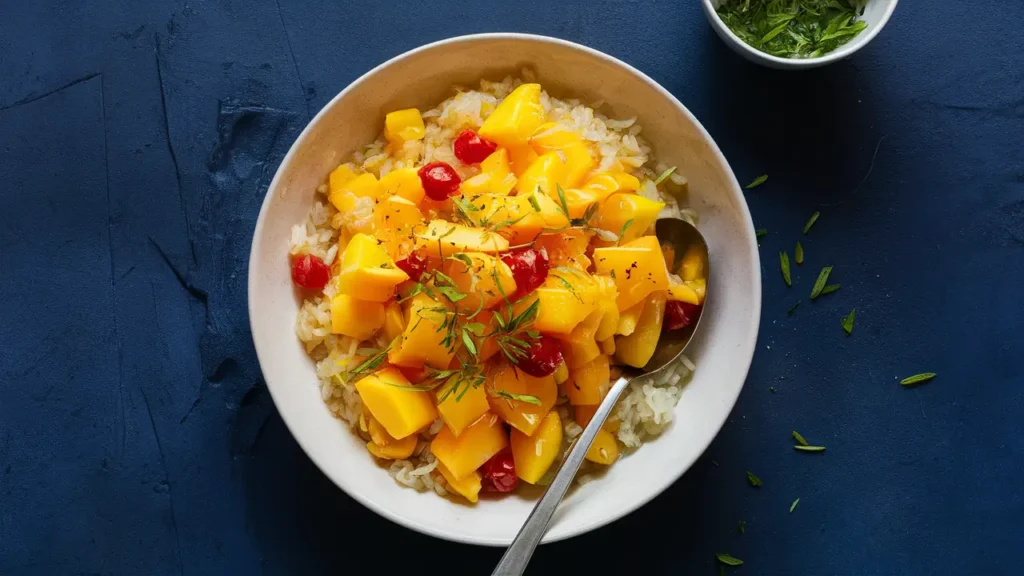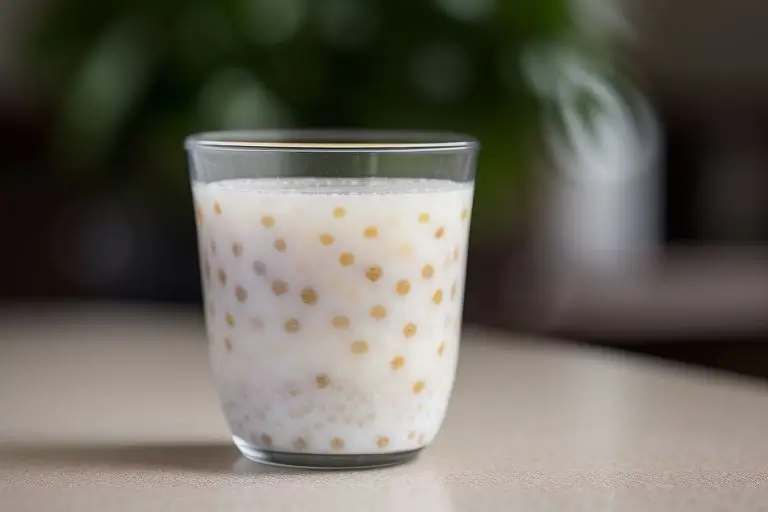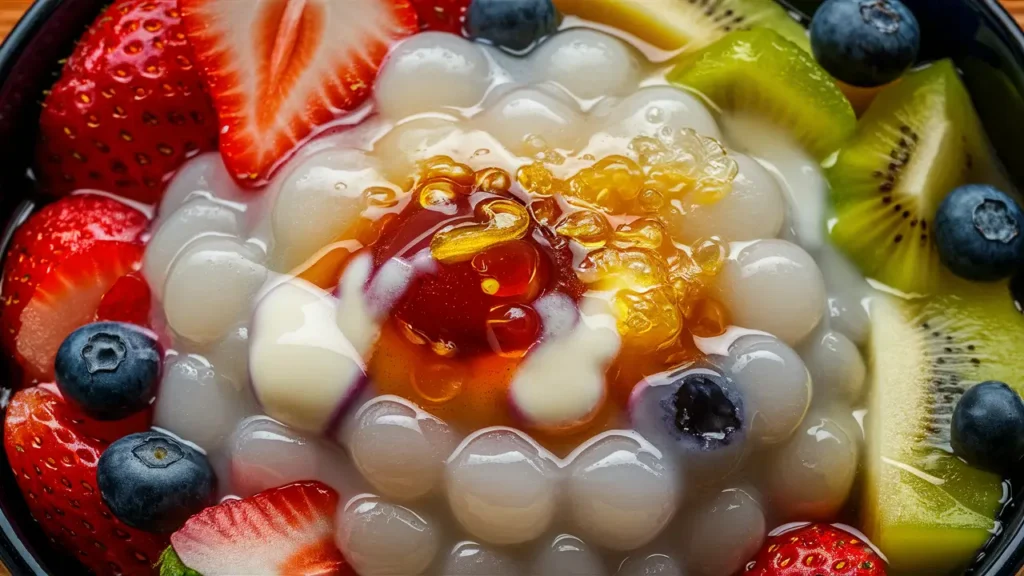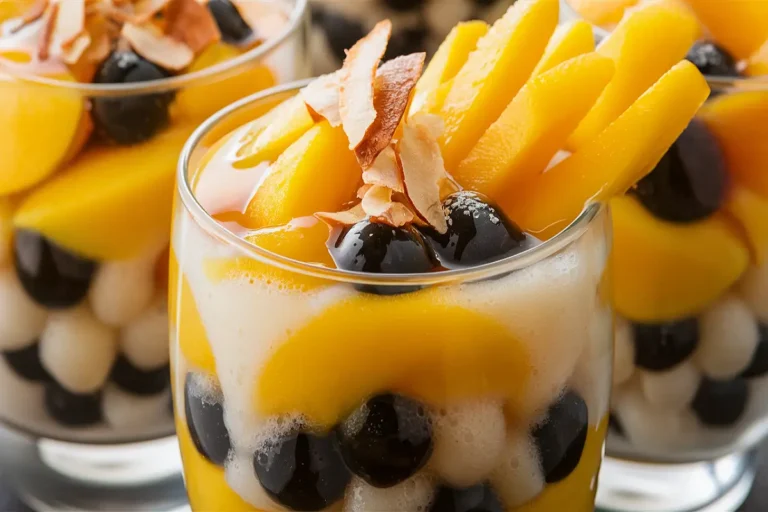Introduction
mango tapioca is not just a dessert; it’s a vibrant celebration of tropical flavors that promises a delightful burst with every spoonful. This dessert perfectly blends the lush sweetness of ripe mangoes with the unique, gummy texture of tapioca pearls, creating a dish that’s both visually appealing and irresistibly tasty.
Definition of Mango Tapioca
Mango Tapioca refers to a sweet dessert comprised mainly of mango puree or chunks and tapioca pearls, which are made from the starch of the cassava root. This dessert is often enhanced with coconut milk or cream, adding a rich, creamy texture that complements the tanginess of the mangoes.
Overview of Its Ingredients and Preparation
Ingredients:
- Mangoes: The star of the dish, which can be used either in puree form or as fresh chunks.
- Tapioca Pearls: These provide a chewy contrast to the softness of the mangoes. They must be soaked or cooked to a translucent, gummy texture.
- Coconut Milk: Adds creaminess and a tropical aroma that ties the mango and tapioca pearls together beautifully.
- Sweeteners: Typically, sugar, honey, or condensed milk is used to sweeten the mixture according to taste.
- Additional Flavors: Lime juice, vanilla extract, or pandan leaves can be added for extra flavor.
Preparation:
- Cooking Tapioca Pearls: Begin by boiling the pearls until they are soft inside and translucent. This usually takes about 20-25 minutes. Once cooked, they are rinsed under cold water to stop the cooking process and remove the starch.
- Preparing Mangoes: Depending on the recipe, mangoes are either blended into a puree or chopped into small chunks. This puree can be strained through a sieve for a smoother texture.
- Mixing Ingredients: In a large bowl, combine the cooked tapioca pearls with mango puree and coconut milk. Mix gently until all components are evenly distributed.
- Sweetening the Dish: Add sugar or honey to your taste. It’s important to balance the sweetness with the tanginess of the mangoes.
- Chilling: Refrigerate the mixture until it’s cold. This not only cools the dessert but also allows the flavors to meld together beautifully.
- Serving: Serve chilled with additional mango chunks or a sprinkle of toasted coconut flakes on top for added texture.
Mango Tapioca can be served as a refreshing end to a meal or as a cool treat on a warm day. Its simplicity, combined with the exotic appeal of its ingredients, makes it a favorite among both adults and children alike. This dessert not only showcases the versatility of mangoes but also introduces the palate to the playful texture of tapioca pearls, making it a must-try dish for anyone looking to explore tropical flavors in their kitchen.
This delightful dessert exemplifies how simple ingredients can be transformed into a sumptuous feast for the senses. It invites an exploration into the world of tropical flavors, promising a little adventure in every bite.

Key Ingredients
Tapioca Pearls
Tapioca pearls, the cornerstone of this dessert, are small, spherical beads made from tapioca starch, an extract of the South American cassava root. These pearls come in various sizes, but the small-to-medium “pearl” variety is preferred for desserts like Mango Tapioca for their pleasant, chewy texture once cooked.
Selection and Preparation:
- Quality: Opt for pearls that are uniform in size and free from impurities. The pearls should be dry and hard in their raw form.
- Soaking: Some recipes require soaking the pearls before cooking, which helps in reducing the cooking time and achieving a consistent texture.
- Cooking: Boil the pearls until they are completely translucent and no white spot remains at the center, ensuring a perfectly chewy texture without being mushy.
Mangoes
Mangoes are the soul of this dessert. The type of mango can significantly affect the flavor and overall quality of the Mango Tapioca.
Types of Mangoes:
- Alphonso: Known as the king of mangoes, Alphonso mangoes are rich, creamy, and incredibly flavorful, with a sweet profile that blends well with the neutrality of tapioca pearls.
- Carabao: Also known as Philippine mangoes, these are sweeter and more aromatic, providing a distinctive lushness to the dessert.
- Kent and Tommy Atkins: These varieties are juicier and slightly tangier, offering a refreshing zest that complements the sweet base of the dessert.
Preparation:
- Ripeness: The mangoes should be fully ripe, imparting natural sweetness and vibrant color to the dessert.
- Processing: Mangoes are either blended into a smooth puree or finely chopped to be mixed with the cooked tapioca pearls. The puree is sometimes sieved to ensure a velvety texture devoid of fibrous bits.
Other Essential Components
Coconut Milk:
The inclusion of coconut milk introduces a creamy texture and subtle tropical flavor that marries well with the mango. It softens the chewiness of the tapioca pearls, providing a rich mouthfeel.
Sweeteners:
- Sugar: White granulated sugar is commonly used, but can be substituted with brown sugar or honey for a deeper flavor.
- Condensed Milk: Often used as a sweetener and to enhance creaminess, it complements both the mango and the tapioca pearls beautifully.
Flavor Enhancers:
- Lime Juice: A few drops can be added to brighten up the flavors, providing a nice acidic balance to the sweetness of the mangoes.
- Pandan Leaves: In some Southeast Asian recipes, pandan leaves are used during the boiling of tapioca pearls to infuse a subtle, aromatic flavor that pairs well with coconut and mango.
- Vanilla Extract: A splash of vanilla adds a warm, complex aroma that doesn’t overpower but enhances the natural flavors of the main ingredients.
Garnishes:
- Mango Chunks: Additional fresh mango chunks not only improve the presentation but also give a more intense mango flavor and varied texture.
- Toasted Coconut Flakes: Sprinkling toasted coconut flakes on top of the Mango Tapioca adds a delightful crunch and nuttiness that contrasts the creamy texture of the dessert.
- Mint Leaves: A few mint leaves can be used as a garnish to add a fresh, clean finish to the dessert.
Each ingredient in Mango Tapioca plays a pivotal role, from the base of tapioca pearls absorbing the rich, sweet blends of mango and coconut, to the various enhancers that round out the flavor profile, creating a dessert that’s not only fulfilling but also a joy to savor. This harmonious blend of textures and flavors makes Mango Tapioca a distinguished dessert that captivates palates with its simplicity and elegance.

Traditional Recipe
Step-by-Step Preparation Process
Creating Mango Tapioca involves a sequence of precise steps—from preparing the tapioca pearls to assembling the final dessert. Follow this method for a classic rendition of this beloved treat.
1: Preparing the Tapioca Pearls
- Soak the Pearls (Optional): Soak about 1 cup of small tapioca pearls in water for at least 30 minutes and up to 2 hours if they are the hard variety. This step is optional but can reduce cooking time.
- Cook the Pearls: Drain the soaked pearls. In a large pot, heat 6 cups of water until it reaches a boiling point. Add the tapioca pearls and stir gently. Reduce the heat to a medium-low and let the pearls simmer. Cook them until they are completely transparent and no white spots remain, about 15 to 20 minutes, stirring occasionally to prevent sticking.
- Cool and Rinse: Drain the pearls and rinse them under cold water to stop the cooking process and remove excess starch.
2: Preparing the Mango
- Peel and Dice: Peel 2 large ripe mangoes. Cut one into small chunks to be used as garnish and blend the other one into a smooth puree in a blender.
- To achieve an exceptionally smooth texture, you may choose to strain the mango puree through a fine-mesh sieve, eliminating any fibers and large particles.
3: Combining the Ingredients
- Mix Ingredients: In a large mixing bowl, combine the cooled tapioca pearls with the mango puree. Add 1 cup of coconut milk for creaminess and mix gently to incorporate fully.
- Sweeten the Mixture: Add sweetener to taste. Start with about 1/4 cup of sugar or honey and adjust depending on the sweetness of the mangoes and your preference.
- Flavor Enhancement: Enhance the flavor with a teaspoon of vanilla extract and the juice of half a lime. Mix well.
4: Chilling
- Refrigerate: Transfer the mixture to a serving dish or individual cups. Refrigerate for at least 1 hour to allow the flavors to meld together and the dessert to set slightly.
5: Serving
- Final Touches: Serve the chilled Mango Tapioca garnished with fresh mango chunks, a sprinkle of toasted coconut flakes, and a few mint leaves.
Proportions and Cooking Methods
Ingredients Proportions:
- Tapioca Pearls: 1 cup (small pearls preferred)
- Water: 6 cups for boiling
- Ripe Mangoes: 2 large
- Coconut Milk: 1 cup
- Sugar or Honey: 1/4 cup (adjust based on sweetness of mangoes)
- Vanilla Extract: 1 teaspoon
- Lime Juice: From half a lime
- Garnish with toasted coconut flakes and fresh mint leaves.
Cooking Methods:
- Boiling Tapioca Pearls: It’s crucial to ensure the water is boiling before adding the tapioca pearls to prevent them from sticking together. The pearls should be stirred gently while cooking to maintain an even texture.
- Blending Mangoes: The mangoes should be blended until completely smooth, which ensures that the puree mixes uniformly with the other components.
- Mixing Techniques: Use a folding technique to combine the tapioca pearls with the mango puree and coconut milk to keep the pearls from breaking apart and to ensure a homogenous texture.
- Chilling: Proper chilling allows the flavors to integrate and the tapioca pearls to soak up the mango and coconut milk, enhancing the overall texture of the dessert.
This traditional Mango Tapioca recipe provides a creamy, refreshing dessert that’s perfect for warm weather or as a sweet finish to a festive meal. The balance of sweet mango and rich coconut milk with the unique, chewy texture of tapioca pearls makes this dish a delightful treat that’s sure to impress.

Variations in Ingredients
Mango Tapioca, while delightful in its traditional form, can be customized in various ways to accommodate different tastes or available ingredients. Exploring variations can lead to the discovery of equally tantalizing versions of this classic dessert.
Different Types of Tapioca Pearls
Tapioca pearls, the bouncy, gelatinous spheres that define the texture of Mango Tapioca, are available in several forms, each bringing a unique texture and aesthetic to the dish.
Small White Pearls:
- Description: These are the most commonly used pearls in desserts. They cook quickly and offer a pleasantly chewy texture without being overpowering.
- Use: Perfect for a more refined, delicate dessert where the mango is the star.
Large Black Pearls (Boba):
- Description: Often used in bubble tea, these pearls are larger and have a more pronounced chewy texture. They are black due to the addition of brown sugar or caramel coloring during processing.
- Use: Ideal for a more substantial, trendy dessert. They make a visual impact and add a fun texture contrast.
Colored Tapioca Pearls:
- Description: These pearls have been dyed different colors using food coloring. They are visually striking and can be used to match or contrast the color of the mango.
- Use: Great for festive occasions or themed parties where visual presentation is key.
Jelly Tapioca Pearls:
- Description: These are made from a mixture of seaweed extract and starch, giving them a more gel-like texture with a crunch.
- Use: Suitable for those looking for a different kind of chewiness, slightly crisper and less gummy than traditional pearls.
Alternative Fruit Options
While mangoes are a popular choice, other fruits can also complement or replace mangoes in the recipe, offering a new spectrum of flavors and colors.
Peach Tapioca:
- Fruit Used: Peaches
- Preparation: Blend or mash ripe peaches to a puree and mix with tapioca pearls.
- Flavor Profile: Peaches provide a sweet, slightly tart flavor that is lighter than mango but equally refreshing.
Pineapple Tapioca:
- Fruit Used: Pineapple
- Preparation: Use finely chopped or crushed pineapple combined with its juice for intense flavor.
- Flavor Profile: Pineapple adds a tropical, zesty taste and a bit of acidity, which balances the sweetness of the tapioca and coconut milk nicely.
Berry Tapioca:
- Fruit Used: Mixed berries (such as strawberries, raspberries, and blueberries)
- Preparation: Berries can be used whole, sliced, or mashed, depending on their size and the desired texture.
- Flavor Profile: Berries introduce a vibrant color and a range of sweet to tart flavors, making the dessert look as good as it tastes.
Lychee Tapioca:
- Fruit Used: Lychee
- Preparation: Fresh or canned lychees blended into a puree or chopped finely.
- Flavor Profile: Lychees offer a delicately sweet and floral flavor that pairs beautifully with the coconut milk.
Banana Coconut Tapioca:
- Fruit Used: Bananas
- Preparation: Mash bananas to a creamy consistency.
- Flavor Profile: Bananas add a creamy, rich texture and a naturally sweet flavor, reducing the need for added sweeteners.
Tips for Experimenting with Fruits
When venturing beyond mangoes in your Tapioca dessert, consider these pivotal guidelines to enhance your culinary creation:
Choose Ripe, Flavorful Varieties
Firstly, select fruits that are at the peak of their ripeness. This ensures the dessert is naturally sweet and packed with flavor, consequently reducing the need for additional sweeteners.
- Why It Matters: Ripe fruits not only provide the best taste and natural sugars but also contribute vibrant colors and aromas to the dessert. Moreover, they enhance the overall sensory experience of the Mango Tapioca.
- Pro Tip: Seasonal fruits often offer the best flavor and value. For instance, opt for peaches in the summer or citrus fruits in the winter to infuse a seasonal twist.
Consider Texture
The texture of the fruit can significantly affect the consistency of the dessert. For example, bananas can thicken the mixture, whereas berries might create a more fluid consistency.
- Adjusting Consistency: Depending on the fruit’s moisture content, you may need to vary the amount of coconut milk or tapioca pearls. Specifically, for juicier fruits, reduce the liquid slightly; conversely, for drier fruits, you might add more.
- Why It Matters: Achieving the perfect texture is crucial for the sensory experience of Mango Tapioca. It should be creamy yet have enough body to support the chewy pearls and fruit pieces.
Balance Sweetness and Acidity
Fruits vary not only in sweetness but also in acidity. This variation can dramatically influence the flavor profile of your dessert.
- Adjusting Flavors: Add a touch more sweetener if the fruit is tart, such as kiwis or certain berries. Conversely, reduce the sweetener for very sweet fruits like ripe pineapples or lychees.
- Why It Matters: The right balance between sweet and tart flavors is key to a refreshing and enjoyable Mango Tapioca. It enhances the dessert’s complexity and appeal.
Incorporating These Fruits
Furthermore, when incorporating different fruits into the Mango Tapioca, here’s how you can proceed:
- Preparation: Begin by preparing the tapioca pearls as described earlier. Ensure they are rinsed and drained well.
- Fruit Processing: Puree or finely chop the chosen fruits. Consider straining if you desire a smoother consistency, especially with berries that have seeds.
- Mixing: Combine the prepared fruits with the tapioca pearls. Gradually mix in the coconut milk, adjusting the quantity to achieve your desired creaminess.
- Flavor Balancing: Taste and adjust the sweetness. If using tart fruits, you might want to add a bit more sweetener. Lime or lemon juice can brighten the flavors, especially with sweeter fruits.
- Chill and Serve: Allow the dessert to chill thoroughly. This not only cools the dish but also helps the flavors to meld together beautifully.
Example Variations
Lastly, consider these variations for your Mango Tapioca:
- Berry Tapioca: Mix a combination of strawberries, raspberries, and blueberries. Adjust the coconut milk to ensure the tapioca pearls and berries come together in a harmonious texture.
- Pineapple Tapioca: Use finely chopped pineapple for a tropical twist. The acidity of the pineapple beautifully offsets the sweet tapioca and coconut milk.
- Lychee Tapioca: This version is wonderfully aromatic. The lychees offer a floral, sweet taste that is unique and refreshing.
FAQs
Where is mango sago from?
- Mango Sago originates from Southeast Asia, particularly popular in countries like Thailand, Malaysia, and the Philippines, where it’s a beloved dessert.
Which is healthier, sago or tapioca?
- While both sago and tapioca offer minimal nutritional value, tapioca is slightly healthier with fewer calories and carbohydrates compared to sago.
How to make tapioca step by step?
- To make tapioca, soak tapioca pearls in water for 30 minutes, then boil until translucent, stirring occasionally. Drain, rinse, and it’s ready to use in various dishes.
Is tapioca the same as sago?
- Tapioca and sago, though similar, are derived from different sources. Tapioca comes from cassava root, while sago is extracted from the pith of various palm trees, resulting in slight differences in texture and taste.

